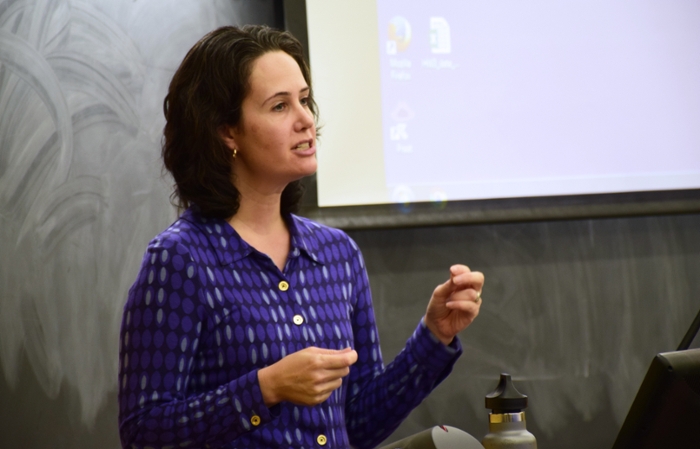Faculty Spotlight: Heather Schoenfeld
IPR sociologist/legal scholar brings historical perspective to studies of criminal punishment
Get all our news

IPR sociologist/legal scholar Heather Schoenfeld studies mass incarceration and criminal justice policy.
A few years out of college, IPR sociologist and legal scholar Heather Schoenfeld went to work as a research associate for the Midtown Community Court in New York City, the nation’s first community court, established in 1993.
While at Midtown, which emphasized alternative sentencing and intervention services for low-level criminal offenders, Schoenfeld witnessed a criminal justice approach that sought to minimize incarceration.
The experience furthered her interest in understanding how we had come to this “place” of mass incarceration. To “step back and get the bigger picture,” she decided to pursue a PhD in sociology at Northwestern University.
Today, Schoenfeld applies a historical-sociological lens to understanding how the United States became the world's biggest jailer, and how reforms might come about to change it.
Tracing the Rise of the Prison State
In her forthcoming book, Building the Prison State: Race and the Politics of Mass Incarceration (University of Chicago Press), Schoenfeld uses an in-depth case study of Florida, a state with one of the largest prison populations, to examine the development of mass incarceration in the United States from 1950 to the present.
In the United States, the rise of mass incarceration is usually depicted as a result of politicians suddenly deciding to get “tough on crime,” but Schoenfeld says that “many states had tough on crime cultures early on when incarceration rates were much lower.”
So what changed?
Drawing on archival evidence and interviews with key stakeholders in Florida, Schoenfeld focuses on capacity, showing how the government’s ability to detect crime and punish individuals grew in the 1970s and '80s due to the professionalization of policing, increased funding, and eventually the building of more prisons.
“I see the politics of crime not really taking off until the 1990s,” she said, noting that “tough on crime” became a more advantageous political stance when “the prisons had been built and there was space to put people.”
As discussions around mass incarceration continue, Schoenfeld’s book explains how we got to this point. Taking a historical view is important, she explained, as past laws and policies “have had a concrete impact on maintaining high levels of incarceration.”
Studying State-Level Prison Reforms
Over the last 10 years, a number of states have experimented with prison reform, with many characteristically Republican states like Texas and Georgia leading the way.
Using a series of paired state-level case studies—comparing similar states with different reform trajectories—Schoenfeld and Michael Campbell of the University of Missouri, St. Louis are examining why certain states have passed decarceration reforms while others have not, or have passed more limited reforms.
They find that much of the state-level conversation centers on “cost containment.” Between falling crime rates, the Great Recession, and the rise of Tea Party politics, many conservative states began to pursue prison reform to “shrink the state” and save money.
These motivations, along with a value-based motivator—an “elite, conservative movement based on Christian principles of giving people a second chance”—have led typically conservative states to push prison reform.
Yet red states are not the only ones looking to lower their prison populations. Schoenfeld’s ongoing research also looks at why some blue states, such as New Jersey, have reduced their incarceration rates.
The ongoing project will exploit state-level variation to understand the networks of people, resources, and processes that are effective in reducing incarceration within different states.
“Most incarceration happens in state prisons,” Schoenfeld explained. “So to really understand how we got here, and what we can do about it, we need to focus at the state level.”
Capturing the Politics of Policy
While conducting interviews with key stakeholders in Florida for her book project, Schoenfeld discovered firsthand the role of politics in criminal justice policy.
When asked why the state built so many prisons in the 1980s and '90s, many Floridians cited a federal court case, Costello v. Wainwright, as the impetus for prison building.
However, Schoenfeld, a legal scholar, noted that the court case simply told legislators to reduce prison overcrowding; it did not mandate more prisons.
So why did Florida legislators interpret the court case to call for a massive prison building program?
“It all had to do with politics,” Schoenfeld said.
From the War on Drugs at the federal level to the changing politics of crime at the state level, the political climate of the 1980s and '90s sparked prison building in Florida—and beyond. In addition, Schoenfeld notes, the willingness to build prisons went hand-in-hand with an indifference to the disproportionate impact of prisons on black Floridians.
“When we talk about policy ideas…it is vitally important that we look at the political context,” she explained.
As she seeks to expand her research agenda on the politics of policy, Schoenfeld emphasizes why researchers must keep political contexts in mind.
“As researchers, we need to be cognizant of questions about how policymakers use science and social science and the knowledge that research generates,” she said.
Heather Schoenfeld is assistant professor of legal studies and social policy, and an IPR fellow.
Published: May 1, 2017.